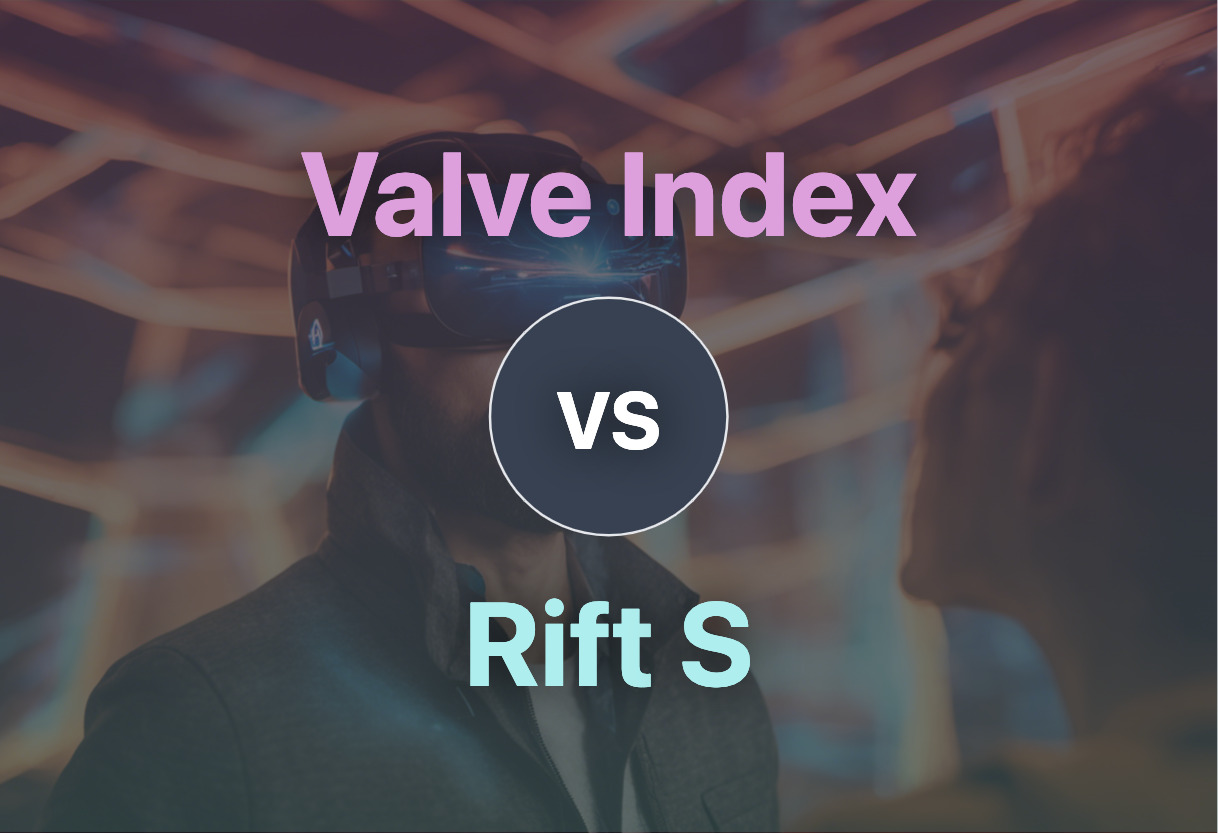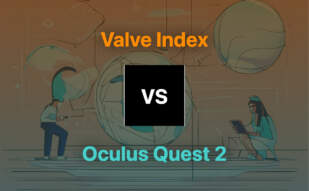If you’re breaking into the VR space and need an innovative, high-end headset, choose the Valve Index. Its superior display clarity trumps the Rift S, and detailed hand tracking offers extra immersion. However, if cost is a concern, the Rift S at $399, delivers sufficient detail and tracking for a solid VR experience.

Key Differences Between Valve Index and Rift S
- Price: Valve Index starts at $799, while Rift S is priced at $399.
- Display: Index boasts dual 1440 x 1600 RGB LCDs, while Rift S uses a 2560×1440 LCD screen.
- Tracking: Index uses SteamVR 2.0 sensors for compatibility with HTC Vive and Vive Pro Controllers; Rift S relies on Oculus Insight tracking for gaming.
- Integration: Index is compatible with Steam and hardware agnostic, while Rift S is compatible with Oculus Store, Viveport store, and Steam VR.
| Comparison | Valve Index | Oculus Rift S |
|---|---|---|
| Initial Release | June 28, 2019 | March 2019 |
| Manufacturer | Valve | Facebook Technologies, Lenovo |
| Price | $799 (Headset only), $999 (Full kit) | $399 |
| Operating System | Windows, Linux | Windows |
| Resolution | 1440 x 1600 per eye | 1280 x 1440 per eye |
| Refresh Rate | 80/90/120/144 Hz | 80 Hz |
| Field of View | 130° (Approx.) | 115° |
| Audio | Off-Ear Audio Solution | Integrated Speakers, 3.5mm Jack |
| Connections | USB 3.0, DisplayPort 1.2 | DisplayPort 1.2, USB 3.0 |
| Store Compatibility | Steam | Oculus Store, Steam VR, Viveport |
| Tracking Technology | SteamVR 2.0 Sensors | Oculus Insight |
| Controller Tracking | 87 Sensors for Hand/Finger Tracking | Oculus Touch Controllers |
What Is Valve Index and Who’s It For?
Valve Index is a premium, second-generation VR headset developed entirely by Valve. Launched on June 28, 2019, with an initial offering of 149,000 sets, it provides striking clarity and boundary-pushing immersion aimed at tech enthusiasts and gamers seeking absolute VR precision. Offering compatibility with Windows and Linux, it operates on a system designed to optimize optical comfort for longer play sessions.
Catering to the diversity of user head and ear shapes, Valve Index features adjustable optics and innovative off-ear audio solutions. This proper VR headset boasts an impressive track record but comes with a premium price tag and a scarcity in supply.

Pros of Valve Index
- Superior display with dual 1440 x 1600 RGB LCDs
- Advanced ergonomics for optimal comfort
- Compatible with HTC Vive and Vive Pro Controllers
- Multiple frame rate options for extended play
Cons of Valve Index
- High price point
- No eye tracking feature
- Complicated room-scale sensor setup
- Conspicuous audio output
What Is Rift S and Who’s It For?
The Rift S, built by Facebook Technologies and Lenovo, is a VR headset that bridges the gap between avid gaming and virtual reality. Launched as a successor to the original Oculus Rift in March 2019, it features “inside-out” tracking, higher resolution display, and sheds the need for external sensors. Aimed at gamers seeking compact, integrated solutions, the Rift S brings adaptability and comfort at a friendlier price point.
Adaptable to a wide range of engaging VR content, it allows user exploration through Oculus Store, Viveport store, and Steam VR. However, in the virtual arms race, it’s been criticized for not taking a giant leap from its predecessor.

Pros of Rift S
- Improved “inside-out” positional tracking system
- Next-generation lens technology
- Comfort-enhanced design
- Product accessibility and compatibility
Cons of Rift S
- Seen as only an incremental upgrade over the original
- Fixed lens with limited IPD adjustment
- Ceased production in June 2021
- Compromise between affordability and performance
Valve Index vs Rift S: Pricing
Purchasing the Valve Index requires a larger financial commitment with a price tag of $799 for the headset only and $999 for the full kit, whereas the Rift S stands at a flat rate of $399.
Valve Index
Initially introduced at $999, the Valve Index is now sold for $799 for the headset only. For those interested in acquiring the full kit, the cost stands at $999. Considered a premium headset, Valve Index is positioned at a higher price point compared to its competitors.
Rift S
The Rift S, developed by Facebook Technologies and Lenovo, was launched with a decidedly more budget-friendly pricing strategy, carrying a flat cost of $399. Its price, coupled with its advanced features, makes it an appealing contender in the consumer VR headset market.
The Final Verdict | Valve Index VS Rift S
Given the detailed specifications and unique aspects of Valve Index and Rift S, the choice truly hinges on your particular needs and budget constraints. Let’s outline the reasons different audience groups might prefer one over the other.
PC Gaming Enthusiasts
Valve Index wins over this segment due to its superior refresh rates, improved tracking, and controller precision. With SteamVR compatibility and high-definition displays, Valley Index excels in providing an immersive gaming experience – an essential for PC gamers.

VR Developers and Creatives
For these individuals seeking innovative room-scale tracking features and software flexibility, Rift S is the optimal choice. It’s complete with a higher resolution display, Oculus Insight tracking tech, and ‘Passthrough+’ safety feature, providing a solid foundation for creative and development work in VR.

Budget-Conscious Users
Cost plays a significant role in this segment, making Rift S the preferred choice due to its comparably lower price at $399. A combination of crucial features such as the next-generation lens technology, a comfortable halo headband, in-built speakers, and software updates make Rift S a rich yet affordable VR experience.

If you’re seeking an immersive, high-performance VR gaming experience and have a loose budget, opt for Valve Index. However, if you require an all-rounded, budget-friendly VR set that doesn’t compromise on essential features, Rift S, despite being just an upgrade over the original, serves as the “gold standard” in its category.
Tiffany Brise
Content writer @ Aircada, patiently awaiting a consumer AR headset that doesn’t suck.





